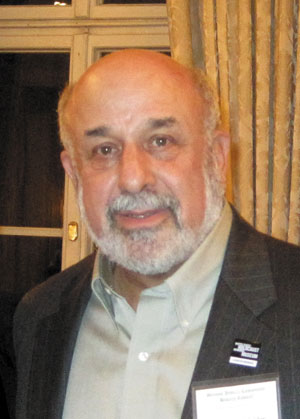Museum’s milestone celebrated with tributes to survivors and WWII veterans
Published May 10, 2013
At the recent 20th Anniversary Gala for the United States Holocaust Memorial Museum in Washington, D.C., Elie Wiesel spoke passionately about the Shoah to the many young people in the crowd saying, “You are the flag bearers…your memory inherits ours.” He asked that succeeding generations not dwell on “What would I have done?” and instead focus on “What will I do?” to ensure the lessons of the Holocaust are not forgotten.
Of the 3,600 attendees, 850 were survivors and 140 were veterans/liberators. It was anticipated that this would be the last official gathering of these groups. As a result, a great deal of the programming was created to honor them and, for the survivors, the memories of their family members who did not survive. The museum’s highest honor, the Elie Wiesel Award, was presented to all World War II veterans and accepted on their behalf by Susan Eisenhower, granddaughter of President Dwight Eisenhower, and to a Polish rescuer as a representative of all rescuers.
ADVERTISEMENT
As chairman of the Holocaust Museum & Learning Center here in St. Louis, I have the opportunity, indeed the privilege, of spending a lot of time with our own group of Holocaust survivors. Each has a unique story to tell; and each is passionate about ensuring that his or her story be told to the widest audience possible. The 30,000 visitors to the museum each year may be the last generation to have the opportunity to listen to, and ask questions of, these “treasures,” whose life experiences and memories of the Holocaust we find it difficult to imagine.
It was with this background that I spent a very inquisitive two days at the gala. Every survivor and WWII veteran had been given a badge identifying them as such, though many veterans were easy to spot because they wore their uniforms, hats or medals. I approached as many people as I could, introducing myself and asking about their story, where they came from, where and when were they incarcerated in a camp (or in many instances, camps), their story of being liberated, and where they lived now. These conversations took place in the hotel lobby, on the shuttle buses to and from the museum, during meals, and in the hallway and foyer of the museum, anywhere I felt I could get a few one-on-one uninterrupted minutes of their time.
Many of them had made the trip to D.C. with their children and grandchildren, who frequently added information to the stories. One thing that impressed me was that virtually all of them speak regularly of their experiences, urging their audiences to learn from the lessons of the Holocaust and to spread the message “never again.” If they lived near a Holocaust museum or memorial they often spoke there. If not they visited schools near where they lived.
Some of them admitted that they had just recently begun to tell their story in public; the pain of their experiences and memories even after 70 years had been too difficult to recount. Some handed me flyers touting a book they had written about their lives. Some had been co-authored by one of their children. At one meal I was visiting with a survivor when another one joined us. They began sharing their stories and upon learning that they both had been liberated from Auschwitz rolled up their sleeves to display their tattooed numbers. It was the most powerful and emotional moment of the weekend for me.
ADVERTISEMENT
For one full afternoon the museum was closed to the public, and those in attendance at the gala could view the new exhibition “Some Were Neighbors, Collaboration and Complicity in the Holocaust,” or sit in on a variety of lectures and interactive discussions on a wide variety of topics.
I also had a chance to visit with Fred Zeidman, a fraternity brother of mine at Washington University (a long time ago) who was chairman of the U.S.H.M.M. from 2002-2010. We discussed today’s common challenges to Holocaust museums and Holocaust education in general, the challenges of delivering a contemporary message about genocide, and the importance and difficulties in engaging the second, third and future generations of survivors while maintaining the messages and memories of the Holocaust. I described to him the new exhibit at the HMLC here, “Change Begins With Me,” an interactive multi-media installation that uses contemporary examples of bias, discrimination and genocide to show that the lessons of the Holocaust have not yet been learned. Both President Bill Clinton and Elie Wiesel in their speeches used the example of Kosovo and Sarajevo, and their combined efforts to try to solve this crisis 20 years ago, to emphasize the worldwide challenge of ongoing genocide.
As he concluded his remarks, Wiesel again spoke to the younger generations in attendance: “You are our witnesses. You are our future. What you do matters. Memory has the power to change the world.”
We can only hope that when we gather 20 years from now the world will able to say: “They listened.”
















